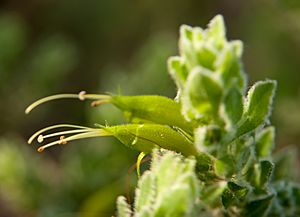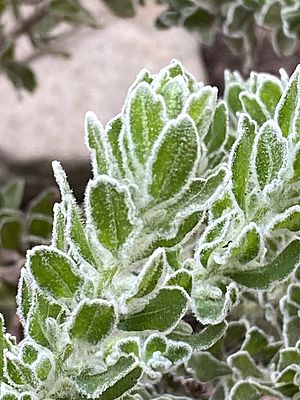Dense-felted eremophila facts for kids
Quick facts for kids Dense-felted eremophila |
|
|---|---|
 |
|
| Eremophila subfloccosa in Kings Park | |
| Scientific classification | |
| Genus: |
Eremophila (plant)
|
| Species: |
subfloccosa
|
The Eremophila subfloccosa, also called the dense-felted eremophila, is a special plant found only in Australia. It's a type of shrub, which is a bushy plant. Its leaves often feel soft and fuzzy because they are covered in tiny hairs. This makes the plant look silvery-grey. If you crush the leaves, they have a strong smell! Its flowers are usually yellowish-green and have long parts called stamens sticking out. This plant often grows well after bushfires, but it can struggle when other plants grow back and compete for space.
Contents
What Does It Look Like?
The dense-felted eremophila is usually a low, spreading shrub. It often grows less than 1 meter (about 3 feet) tall. However, it can spread out to about 2 meters (about 6.5 feet) wide.
Its leaves are usually between 15 and 37 millimeters long. They are also about 5.5 to 11 millimeters wide. The leaves can be egg-shaped, oval, or oblong. Both the leaves and branches are often covered with many soft hairs. This makes the plant feel very soft to touch. These hairs can be different types, depending on the specific kind of Eremophila subfloccosa. The leaves often have a strong scent if you crush them.
The flowers are yellow to green. They grow one by one where the leaves meet the stem. Each flower sits on a small stalk up to 4 millimeters long. This stalk is covered with soft, white hairs. The flowers are shaped like a tube and can be up to 25 millimeters long. At their base, they are surrounded by 5 leaf-like parts called sepals. The flowers do not have spots. The four stamens (the parts that hold pollen) stick out beyond the flower tube. This plant usually flowers in spring. However, it can also flower at other times of the year. After flowering, it produces round fruits that are smooth and about 5 to 9 millimeters wide.
How It Got Its Name
The plant Eremophila subfloccosa was first officially described in 1870. This was done by a scientist named George Bentham. He wrote about it in a book called Flora Australiensis.
The name subfloccosa comes from two Latin words. "Sub" means "somewhat" or "almost." "Floccosus" means "fluffy" or "woolly." This name describes the soft, woolly hairs found on the plant's stems and leaves.
Scientists have recognized three different types, or subspecies, of Eremophila subfloccosa:
- Eremophila subfloccosa subspecies subfloccosa : This type has branches that spread low or lie flat on the ground. It grows to about 0.8 meters (2.6 feet) high and 2 meters (6.5 feet) wide. Its leaves and branches are very hairy. They have branched and sticky hairs, especially thick on the edges of the leaves.
- Eremophila subfloccosa subspecies glandulosa : This type is an upright, sticky shrub. It grows between 0.3 and 1.0 meter (1 to 3.3 feet) high. It can spread between 0.6 and 1.0 meter (2 to 3.3 feet) wide. Its leaves and branches are mostly covered with sticky hairs. These hairs are not as dense on the leaf edges. The name glandulosa means 'covered with hairs that have sticky tips'.
- Eremophila subfloccosa subspecies lanata : This type is an upright shrub that can grow up to 1.2 meters (3.9 feet) tall. Its leaves and branches are covered with white, woolly hairs. This makes the whole plant look grey. The name lanata means 'covered with long, dense, curled, and matted hairs'.
Where It Grows
The dense-felted eremophila grows in dry (semi-arid) parts of Western Australia and South Australia. You can often find it near the Eyre Peninsula in South Australia. It can grow in many different types of soil. It often grows near salty areas and in places that have been disturbed, like next to road verges. This plant often does very well after bushfires. However, it can struggle after a few years when other plants recover and start to compete with it.
Each subspecies grows in slightly different areas:
- Subspecies subfloccosa grows in sandy soils or rocky areas. It is found in disturbed places between Hyden and Wongan Hills in Western Australia.
- Subspecies glandulosa grows in two separate areas. In Western Australia, it is found between Balladonia and Ravensthorpe. It is often seen after bushfires and along roadsides. In South Australia, it grows in several botanical regions, including the Yorke Peninsula.
- Subspecies lanata also grows in two separate areas in two states. In Western Australia, it is found in a wide area between Cue and Rawlinna. It often grows in sandy soils on flat plains and near salt lakes. In South Australia, it is found in regions like the Flinders Ranges and Eyre Peninsula.
Growing It in Your Garden
The soft, silvery leaves of the dense-felted eremophila make it a nice plant for gardens. It grows best in dry areas and needs lots of sunshine. It prefers soil that is alkaline (not acidic) and drains water well. It is easier to grow new plants from cuttings (small pieces of the plant) than from seeds. However, using too much mist when growing cuttings can cause problems with fungus.
Images for kids




